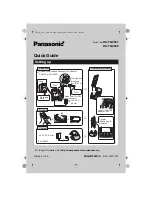
23
5. For each stored number, write the
person’s or company’s name next
to the appropriate location number
on the supplied MEMORY direc-
tory sticker. (Use a pencil in case
you want to change the number
later.) Attach the sticker to the
handset.
To erase a stored number, simply
store a new number in its place. Or,
press
MEMO
twice, then press the
memory location number (
0
–
9
) you
want to clear. A tone sounds.
Entering a Pause
In some telephone systems, you must
dial an access code (
9
, for example)
and wait for a second dial tone before
you can dial an outside number. You
can store the access code with the
phone number. However, you should
also store a pause after the access
code to allow the outside line time to
connect.
To enter a 2-second pause, press
REDIAL/P
. For a longer pause, press
REDAIL/P
additional times.
Dialing a Memory Number
To dial a number stored in the hand-
set’s memory, lift the handset from the
cradle or press
TALK
. When you hear
a dial tone, press
MEMO
and enter the
memory location number for the num-
ber you want to dial.
To dial a number stored in the base’s
memory, press
SPEAKER
. When you
hear a dial tone, press
MEMO
and en-
ter the memory location number for the
number you want to dial.
Chain-Dialing Service
Numbers
When calling special services (such as
alternate long distance or bank-by-
phone), dial the service’s main number
first. Then, at the appropriate place in
the call, press
MEMO
and the number
for the memory location where the ad-
ditional information is stored.
Testing Stored Emergency
Numbers
If you store an emergency service’s
number (police department, fire de-
partment, ambulance) and you choose
to test the stored number, make the
test call during the late evening or early
morning hours to avoid peak demand
periods. Also, remain on the line to ex-
plain the reason for your call.
43-698a.fm Page 23 Friday, August 13, 1999 12:56 PM










































